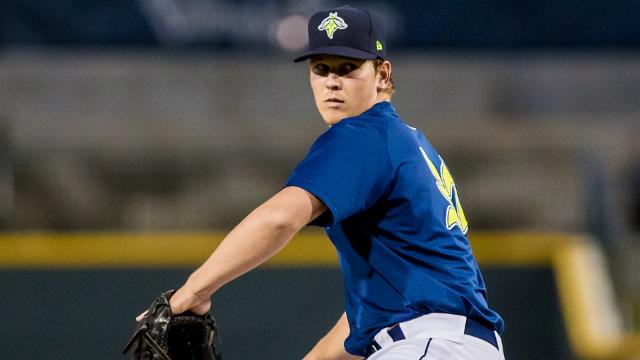Jordan Humphreys
Pos: SP B/T: R/R Age: 6/11/1996 (22)
Acquired: 2015 18th Round Draft Pick from Crystal River High School (Chrystal River, FL)
2017 Stats (Columbia & St. Lucie): 10-1, 1.79 ERA, 0.868 WHIP, 1.3 BB/9, 9.3 K/9
Humphreys spent the entirety of the 2018 on the shelf, recovering from Tommy John surgery (TJS). Unfortunately, TJS has been a harsh reality for many professional baseball players, and in particular, pitchers. Bill James Online notes that, in 2018, more than 25 percent of pitchers had undergone the procedure. An April 2018 piece in The Hard Ball Times showed us that, in 2017, 86.7 percent of all major league games featured at least one pitcher that had undergone TJS.
On the bright side, TJS has a success rate over 90 percent. This means even with Humphreys losing a year in development, we can expect his promising stuff and control to return this upcoming season.
Humphreys started building a degree of notoriety among the Mets organization in 2016 pitching in Kingsport. Clocking in a very nice 69.1 innings of 3.76 ERA, 2.81 FIP, 1.154 WHIP, 9.9 K/9, and 1.9 BB/9, and lead the Appalachian League in strikeouts (76). That performance earned him a promotion to Brooklyn for the end of the season, in which he had one very impressive start (6 IP, ER, BB, 9 K).
Humphreys true breakout season was 2017. Humphreys was named a South Atlantic League All-Star, and he finished the year with another nice 69.2 innings of a 1.42 ERA, 2.16 FIP, 0.718 WHIP, 10.3 K/9, and 1.2 BB/9. This performance earned Humphreys yet another promotion. Unfortunately, that promotion to St. Lucie was short lived as Humphreys’ injured UCL finally gave out, and it was recommended that he have Tommy John Surgery.
Following that 2017 season, Baseball America rated Humphreys as having the best control tool in the Mets organization. That control has been his calling card throughout his professional career.
Humphreys is a three-pitch pitcher whose arsenal is lead by a low-to-mid 90’s fastball that touches 95. What is impressive is the ability to throw this fastball for strike be it up or down, left or right. The fastball is likely about as good as it will get.
Humphrey complements the fastball with a change-up and curveball as his secondary offerings. His change-up plays a bit better than his curve and shows as an above average offering. Humphreys throws his change in the low to mid 80s giving him about a 10 MPH difference from his fastball. He often throws it inside on hitters from both sides of the plate to disrupt tempo. Once again, his control comes to play as he’s able to throw it for strikes regularly.
His curveball has rated from average to flashing slightly above. Baseball America notes its high-spin, and low-70’s velocity as changing eye levels on hitters during his sequencing.
For Humphreys, each one of his pitches is all the more potent because he is able to locate each pitch in different parts of the zone. His ability to throw the pitch where he wants and to change eye levels is what makes him most effective. In the lower levels of the minor leagues, it has led to him racking up big strikeout numbers. What remains to be seen is if those high strikeout numbers will follow him through the upper levels of the Mets farm system when he faces better hitters.
In some ways, that is why his groundball rate is important to examine. One interesting development with Humphreys was his drop in groundball rate. With Kingsport in 2016, he posted a groundball rate of 49.7 percent. It dropped to 39.9 percent in Columbia in 2017. As he continues to develop his secondary offerings, it will behoove him to keep the ball, not only in the ballpark, but also on the ground to ensure his success.
Overall, Humphreys projects to be a back-end of the rotation starter. His having all average or better pitches, with noted excellent control should help his case. With his repertoire and control, he could also succeed in a role similar to how the Rays utilized Ryan Yarbrough and Yonny Chirinos, i.e. a multiple inning reliever and spot starter. With a healthy 2019 season, we will get a clearer picture of just how best the Mets can utilize in the future.
Editor’s Note: Jarred Kelenic, Justin Dunn, Luis Santana, Ross Adolph, Bobby Wahl, Adam Hill, Gerson Bautista and Felix Valerio were all in our original Top 50 before they were traded.
Previous Rankings
50-46 Led by Michael Paez
45-41 Led by Ranfy Adon
40-36 Led by Anthony Dirocie
35-31 Led by Ryley Gilliam
30-26 Led by Chris Viall
25 Carlos Cortes
24 Ali Sanchez
23 Eric Hanhold
22 Luis Carpio
21 Freddy Valdez
20 Walker Lockett
19 Junior Santos
18 Gavin Cecchini


